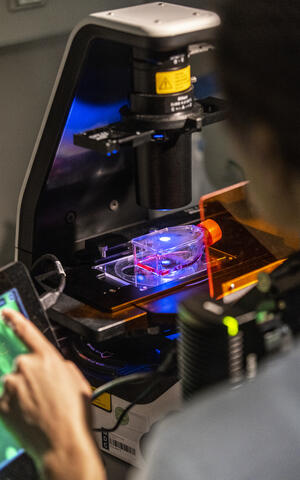A trailblazer in protein recycling
These images are a revelation. Dancing around the screen are blue dots; they represent misfolded proteins moving through the purple-colored membrane system of a living cell’s endoplasmic reticulum – i.e., the highly ramified system of tubes that is essential for the production, quality control, and distribution of essential proteins. “For the first time, we can observe in real time how defective proteins behave and how cells degrade them,” says Professor Thomas Sommer. “Using fluorescence microscopy, we can make all the workings of the ubiquitin-proteasome system visible.”
The ubiquitin-proteasome system is the cell’s recycling center. Ubiquitin acts as a label. It marks proteins that for all sorts of reasons have become defective and thus do not perform their function or are even dangerous, tagging them for degradation. “The cell dismantles the labeled proteins into their component parts, using them to build new proteins,” says Sommer, who leads the Intracellular Proteolysis Lab at the Max Delbrück Center. “It is a perfect recycling system.”
Sommer has devoted his research career to studying this recycling system, or rather to its many components: proteins and amino acids, and the processes they set in motion. For a long time, such processes were only visible in the form of mountains of biochemical data. Fluorescent microscopy now brings to light even minuscule ligases, the enzymes that join proteins together and thus make it possible to mark defective proteins with ubiquitin in the first place. They appear as dancing, colored dots in the tubular labyrinth of the endoplasmic reticulum, thus making it possible to analyze their patterns of movement and various interactions.
Molecular biology as a constant
Analysis of the dynamics of the ubiquitin-proteasome system using a fluorescence microscope.
Sommer is passionate about his research. Although he has led one of Berlin’s largest research institutes for years, he has made sure to keep his feet firmly planted in the world of microbiology. This morning he drives up in his black-and-red Mini, parks outside the main entrance to the Max Delbrück Center, and makes his way to the spacious director’s office. He is wearing a polo shirt and sneakers. An effective communicator who can read people well, he is both charming and ambitious. Good arguments are more important to him than hierarchies. He is someone you can depend on. He was PhD Ombudsperson several times, and he served twice as interim Scientific Director of the Max Delbrück Center, most recently since 2019, guiding it through tumultuous times. In November 2022, he will give up the position and continue with his research in his small office in Building 31, on the long hall with the green studded rubber floor. “Let’s go on over,” he says. On the way he quickly signs a document in the outer office, making a humorous remark about its urgency with typical Berlin sarcasm, and takes the side exit down the outside stairs, the most direct route to his ubiquitin.
Molecular biology has been a constant in Sommer’s life. Even in high school, he wanted to understand how genes and proteins work. In short, he wanted to understand how life functions. Later he joined the Max Planck Institute for Molecular Genetics in Berlin, where he worked with the fungus Neurospora crassa, an organism that turns orange under blue light. For his dissertation, Sommer cloned the genes responsible for this transformation.
Ubiquitin entered his life in 1987. At a conference in Boston, he met a colleague who passionately told him about this small protein with 76 amino acids. Sommer learned that it is found in all higher cells – hence its name: it is ubiquitous – yet no one knew what it did. Sommer gave up his work on fungus and from then on devoted himself entirely to the mysterious ubiquitin. “Back then, ubiquitin research was a tiny field on the verge of opening up,” he says. “It was clear there was a lot to discover.”
The ubiquitin code
Ubiquitin was first discovered in the 1970s. In the 1980s, Aaron Ciechanover, Avram Hershko, and Irwin Rose shed light on the protein’s underlying mechanism and identified the enzyme classes necessary for “ubiquitination” – the binding of ubiquitin to intracellular proteins in order to label them for degradation. In 2004, the three scientists received the Nobel Prize in Chemistry for their work. “At that time, we knew this protein was attached to other proteins and we had some knowledge as to how this happened, but not why,” Sommer recalls. Then, the research field took off. Sommer, too, was driven to find out which cell functions were affected by ubiquitin. Because depending on how many ubiquitins are attached to proteins and the way they are attached, they control a number of other processes in the cell besides recycling – including the cell cycle and transcription, the latter of which being the first step in the formation of new proteins from genetic information.
During his time as a postdoc in Tübingen, Sommer came across an enzyme that plays a key role in ubiquitin-protein binding: Ubc6. “At that time, the idea was floating around that there was a connection between the ubiquitin system and the proteasome,” says Sommer. He realized that Ubc6 is located at a crucial site: the membrane of the endoplasmic reticulum. Here, it works together with other enzymes to perform the first quality control check that proteins must pass through in order to reach their final destination – either inside or outside the cell – in a fully functional state. Otherwise, the protein is shredded by the proteasome. We now know, Sommer explains, that Ubc6 connects defective proteins with the first ubiquitin molecule, thus initiating the labeling process.
The ubiquitin code is a fundamental system that is a long way from being understood.
In the early 1990s, Sommer set up a lab focusing on ubiquitin at the Max Delbrück Center. He experienced first-hand the turbulent early years following German reunification from a research standpoint. “It was a period of transition between two social systems – including in science,” he recalls. In the lab, meanwhile, he continued to dedicate himself to his pet subject. Over time, he discovered more and more enzymes involved in ubiquitination. “It turned out that ubiquitin cannot simply be attached to a protein,” he explains. “First, chains of several ubiquitin molecules must be formed.” After the first bond is made, another enzyme discovered by Sommer (Ubc7) takes care of the chain formation. Only with this attached chain is the protein released for degradation.
“There are numerous ubiquitin chains in the cell, each linked together differently and with its own function,” says Sommer. “The chains can also be branched.” There is a multitude of information contained in these chains that determines what becomes of proteins. This is referred to by scientists as “the ubiquitin code” – a fundamental system that Sommer says is a long way from being understood. Scientists already knew, for example, that the amino acid lysine plays a role in ubiquitin chain formation as a docking site. But in 2016, Sommer and his team discovered that serine and threonine can also have a similar function – allowing them to uncover entirely new possibilities in chain branching and functionality. Then, in 2021, they realized that different types of chains are connected to each other.
Staunchly committed to basic research
When Thomas Sommer talks about the ubiquitin code and its components, he enjoys getting lost in molecular detail. But although he is staunchly committed to basic research, he always has the clinical benefit in the back of his mind. “Practically every therapy comes from basic research,” he says. “And in any case, the divide between the lab and the clinic is an artificial one.” He has consistently fostered this attitude in his various roles at the Max Delbrück Center, helping create the structures that mean researchers here now have the best conditions for both understanding the foundation of life in specialized research groups, and for also developing new therapeutic approaches.
He explains that this also applies to the ubiquitin-proteasome system: “If we want to make good use of medically relevant molecules like ubiquitin in the future, we have to understand exactly how the underlying enzymatic reactions work.” And yet, he says, there are many questions that remain unanswered. Initial therapeutic approaches such as proteasome inhibitors already exist, working by temporarily suppressing the proteasome in the entire body and thus killing cancer cells. A newer approach known as Protac is more targeted: “It uses the ubiquitin-proteasome system to remove only the specific unwanted proteins from cellular events – for example, those that tumor cells need for their growth,” Sommer explains.
Sommer wants to stick to the basics. Instead of using baker’s yeast, his team is now tracking the ubiquitin-proteasome system in various mammalian cells – especially those that have the potential to become muscle cells. New technologies like fluorescence microscopy and proteome analysis by mass spectrometry are helping to locate and shed light on new pieces of the puzzle, so that treatments may one day may be available for diseases such as Alzheimer’s, multiple sclerosis, and cystic fibrosis. These diseases are all closely linked to the cell’s protein recycling system, as misfolded proteins can trigger disease-causing stress in the cell if they are not degraded. The team’s observations of muscle cells are also promising, Sommer says. “But when you intervene in such complex processes, it’s hard to keep an overview of all the different consequences,” he says. “We still need a lot more specific information to fully understand this gigantic network.”
Text: Micro Lomoth








